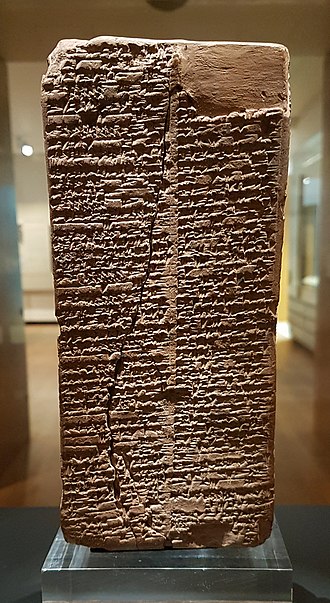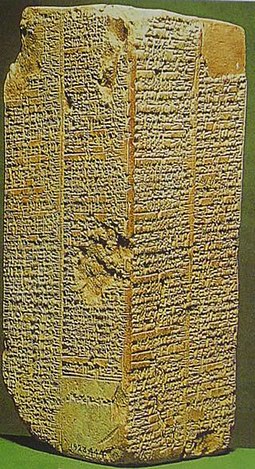Some Background:
The WB44 List is an ancient Sumerian King List.It is written in the Sumerian language on clay tablets. It lists kings of Sumer (ancient southern Iraq) from Sumerian and neighboring dynasties, their supposed reign lengths, and the locations of the kingship. This text is preserved in several recensions. The list of kings is sequential, although modern research indicates many were contemporaries, reflecting the belief that kingship was handed down by the gods and could be transferred from one city to another, asserting to a hegemony in the region.
Where did the list come from:
The sources marked WB are a part of the "Weld-Blundell collection", donated by Herbert Weld Blundell to the Ashmolean Museum. WB 62 is a small clay tablet, inscribed only on one side, unearthed from Larsa. It is the oldest dated source, at c. 2000 BC, that contains the list. WB 444, in contrast, is a unique inscribed vertical prism, dated c. 1817 BC, although some scholars prefer c. 1827 BC. The Kish Tablet or Scheil dynastic tablet is an early 2nd millennium BC tablet which came into possession of Jean-Vincent Scheil, but only contains list entries for four Sumerian cities. UCBC 9-1819 is a clay tablet housed in the collection of the Museum of Anthropology at the University of California. The tablet was inscribed during the reign of the Babylonian King Samsu-iluna, or slightly earlier, with the earliest date of 1712 BC. The Dynastic Chronicle (ABC 18) is a Babylonian king list written on six columns, beginning with entries for the antediluvian (prior to the flood) Sumerian rulers. K 11261+ is one of the copies of this chronicle, consisting of three joined Neo-Assyrian fragments discovered at the Library of Ashurbanipal. K 12054 is another of the Neo-Assyrian fragments from Uruk (c. 640 BC) but contains a variant form of the antediluvians on the list. The later Babylonian king lists and Assyrian king lists repeated the earliest portions of the list, thus preserving them well into the 3rd century BC. At this time, Berossus wrote Babyloniaca, which popularized fragments of the list in the Hellenic world. In 1960, the Apkullu-list (Tablet No. W.20030, 7) or “Uruk List of Kings and Sages” (ULKS) was discovered by German archaeologists at an ancient temple at Uruk. The list, dating to c. 165 BC, contains a series of kings, equivalent to the Sumerian antediluvians, called "Apkullu"
WB PICTURES


MORE KING INFO
Early dates are approximate, and are based on available archaeological data. For most of the pre-Akkadian rulers listed, the king list is itself the lone source of information. Beginning with Lugal-zage-si and the Third Dynasty of Uruk (which was defeated by Sargon of Akkad), a better understanding of how subsequent rulers fit into the chronology of the ancient Near East can be deduced. The short chronology is used here.
None of the following predynastic antediluvian rulers have been verified as historical by archaeological excavations, epigraphical inscriptions or otherwise. While there is no evidence they ever reigned as such, the Sumerians purported them to have lived in the mythical era before the great deluge or flood. Some modern scholars believe the Sumerian deluge story corresponds to localized river flooding at Shuruppak (modern Tell Fara, Iraq) and various other cities as far north as Kish, as revealed by a layer of riverine sediments, radiocarbon dated to c. 2900 BC, which interrupt the continuity of settlement. Polychrome pottery from the Jemdet Nasr period (c. 3000–2900 BC) was discovered immediately below this Shuruppak flood stratum.
The antediluvian reigns were measured in Sumerian numerical units known as sars (units of 3,600), ners (units of 600), and sosses (units of 60).[19] Attempts have been made to map these numbers into more reasonable regnal lengths
One interesting thing. Look at the lengths the kings ruled pre-flood vs. post-flood.
The early chapters of the book of Genesis contain numerical information about the ages of the biblical patriarchs and their chronological relationships during the antediluvian world. They also contain a description of the moral and spiritual condition as well as the history of that period. Although there are other, non-biblical, references to the antediluvian era, there is no other document in all of the extant records of the ancient world that provides the detailed and coherent information found in the book of Genesis. The Genesis account gives us a glimpse into that obscure portion of the history of mankind, and provides information for a chronology of that period. It has, nevertheless, been criticized by non-Christians as well as liberal theologians as being mythological, or at best symbolic and incomplete.
The Sumerian King List, on the other hand, contains an initial section that makes reference to the Flood and to Sumerian kings of extremely long reigns before the Flood.1 The antediluvian portion of the King List is very different from the biblical account. It only contains eight kings, while Genesis has ten patriarchs. The Sumerian list assigns an average reign duration of 30,150 years, with a total duration for the period of 241,200 years, compared to an average age of the biblical patriarchs of 858 years and a sum of 8575 years for their full lives. It also lacks the detailed information of Genesis and its moral and spiritual emphases.